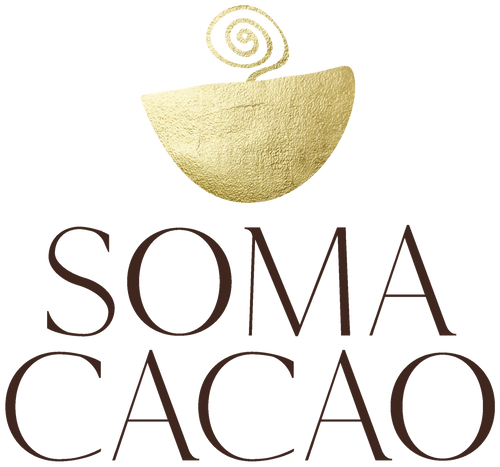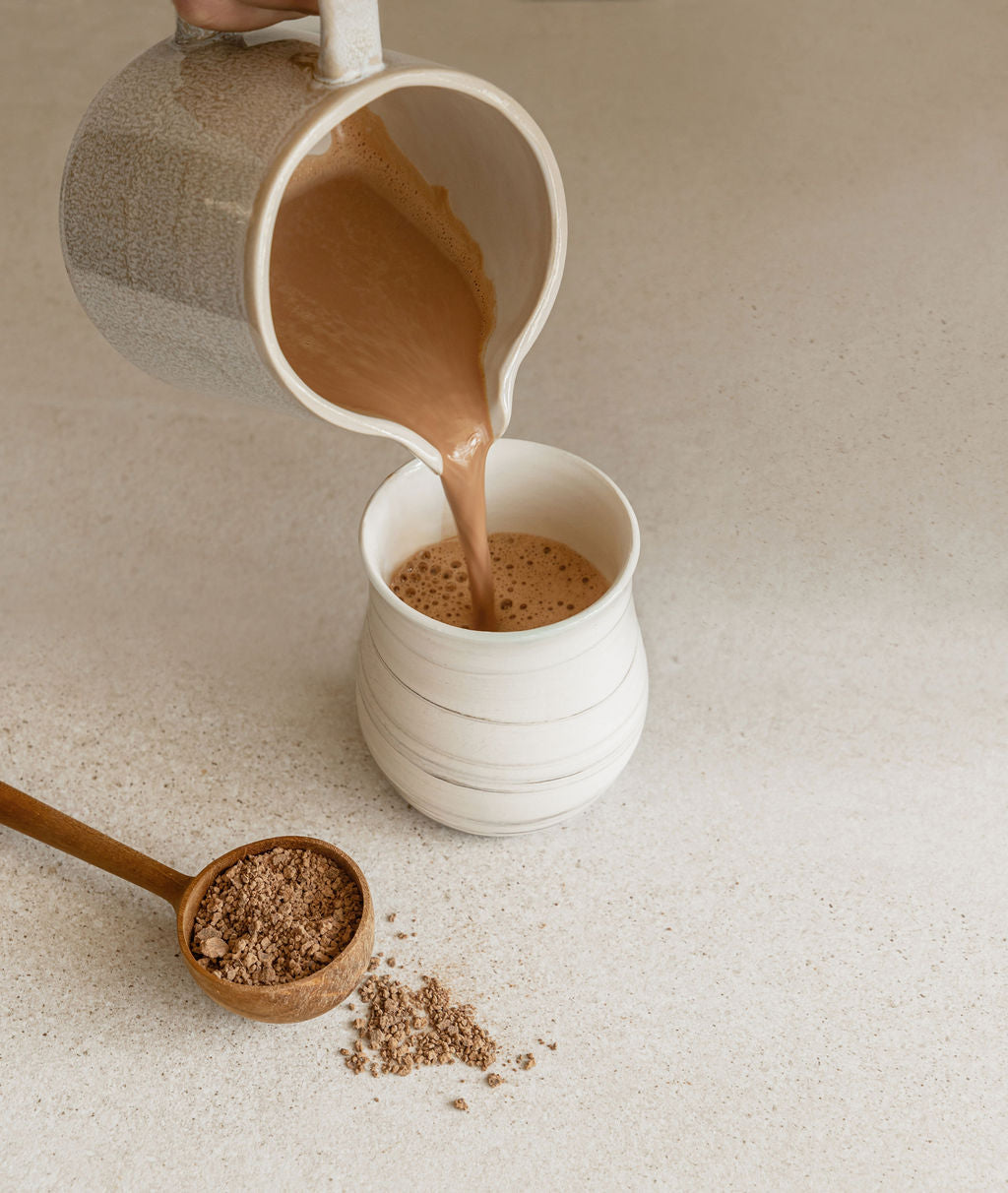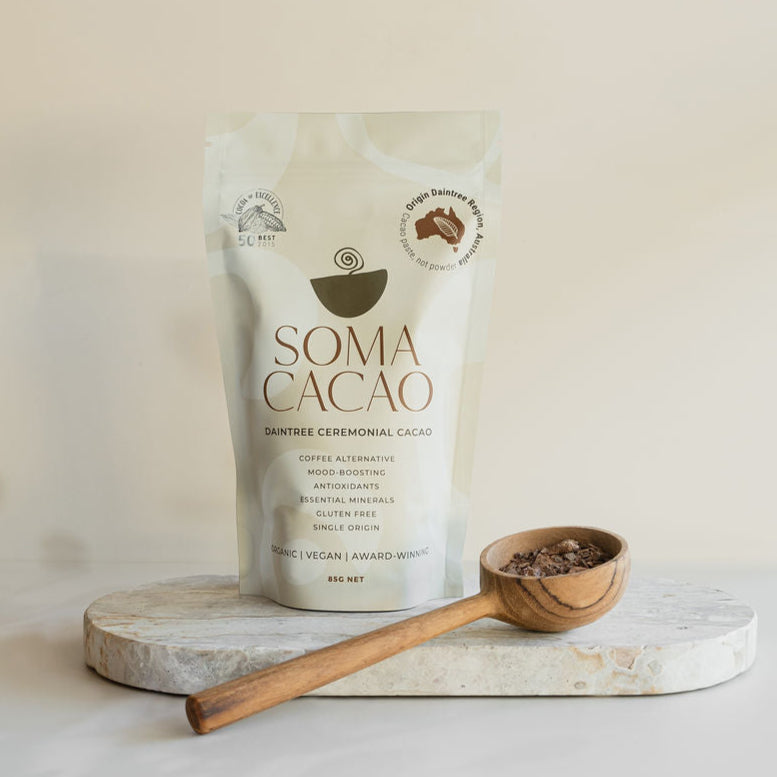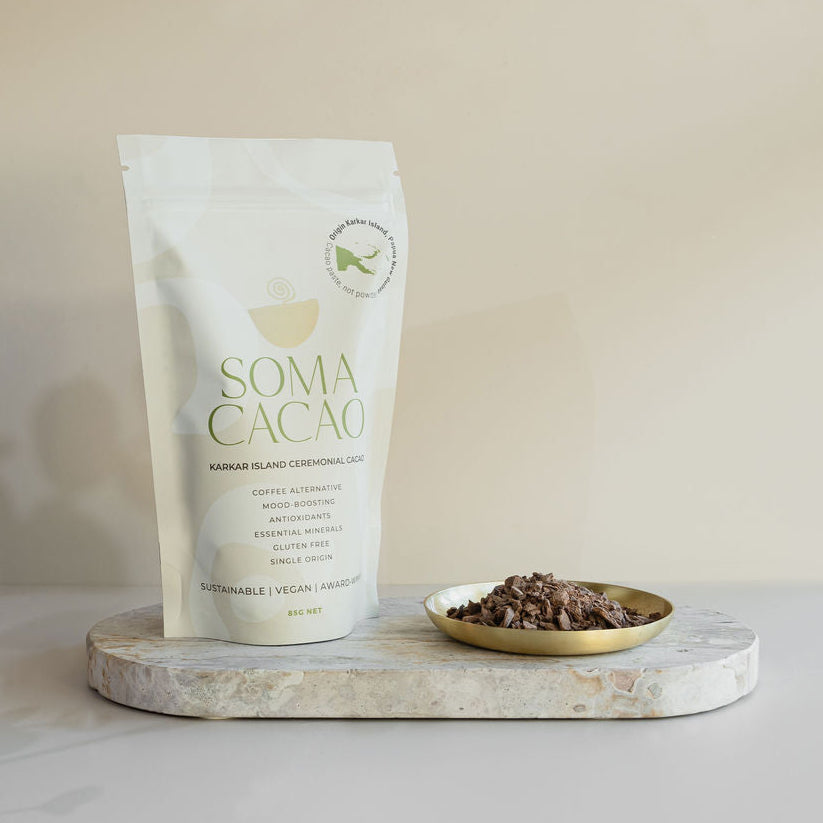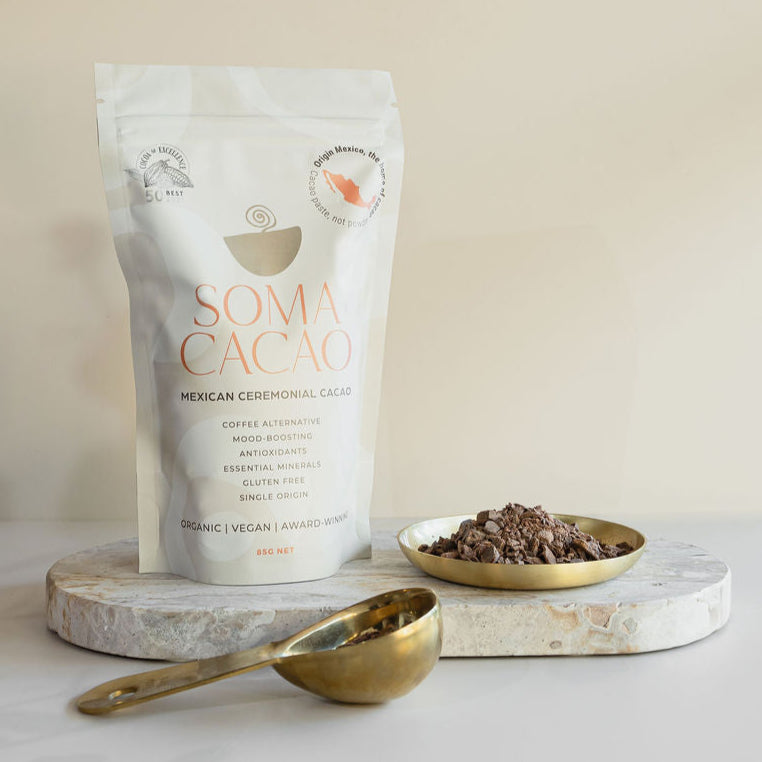CACAO 101: THE BASICS.
-
There is only one ingredient in Soma Cacao: cacao.
It is 100% pure whole-bean cacao paste (as opposed to cacao powder) which is solid at room temperature. We add nothing, we take nothing away.
We’ve shaved up our solidified cacao paste so that you can easily scoop out your preferred dose to prepare your morning cup (or evening nightcap!), or alternatively to sprinkle on cereal, use in smoothies, or make delicious vegan treats. See our recipe page for inspiration.
-
Cacao powder is to cacao what instant coffee is to an espresso - a poor imitation.
Cacao paste contains the whole bean: both the cacao solids and the naturally occurring cacao butter, ground into a smooth, aromatic paste. Nothing added, nothing removed.
Cacao powder is what you get after pressing most of that highly prized cacao butter out. This makes it cheaper to produce, store and transport, but also removes many of the compounds carried by the fat: fat-soluble antioxidants, flavanols, healthy fats like oleic and stearic acid, and the natural “delivery system” that helps your body absorb theobromine and other bioactive compounds.
Most commercial cocoa powders (especially Dutch-processed/alkalised ones) also lose a significant amount of antioxidants during processing - in some studies, up to 60–90%.
So while powder has its place (great for baking and smoothies!) cacao paste is the closest you’ll get to the full chemistry, flavour and richness of the cacao fruit itself.
-
The terms cacao and cocoa are often used interchangeably, but they usually refer to different forms of the same plant.
Cacao typically refers to the whole bean and everything made from it before anything is removed. This includes the pods, beans, nibs, and whole bean cacao paste. Cacao paste contains the full bean, including the naturally occurring cacao butter.
Cocoa usually refers to what’s left after most of that cacao butter has been pressed out to make powder. This process changes both the flavour and the chemistry of the cacao.
You may also see the word cacao used to describe “raw” or low-temperature cacao powder. While raw cacao powder can be a nutritious supplement, it does not contain the same range of compounds as whole bean cacao paste, nor does it offer the same richness, texture, or depth of flavour.
-
Many people find cacao offers a gentler, longer-lasting kind of energy compared to coffee.
Coffee’s primary stimulant is caffeine, which acts quickly on the nervous system. For some people, this can feel intense and short-lived, and may come with jitters, anxiety, or a crash later on.
Cacao works differently. Its main stimulant is theobromine, which has a slower, smoother effect. Rather than spiking the nervous system, theobromine supports circulation by gently widening blood vessels, helping blood and oxygen move more freely through the body. This often translates to energy that feels steadier, calmer, and more sustained.
Because of this, many people experience cacao as both energising and grounding, without the sharp highs and lows they associate with coffee.
We’ve elaborated on this in a recent blog post.. -
Soma Cacao contains a modest amount of caffeine compared to coffee. Depending on the origin, a serving of Soma Cacao's ceremonial cacao has between 17 mg and 47.5 mg of caffeine—significantly less than the 120–180 mg typically found in a classic flat white, slightly less than the 60-80 mg found in matcha, and about the same as a cup of green tea.
This lower caffeine content, combined with higher theobromine levels, offers a smoother, more sustained energy boost. Read more.
-
Our Daintree and Peruvian cacaos are made from certified organic cacao beans, so if the certification is important for you, these are your best bet.
Our Solomon Islands origin was certified organic until recently, but the farmers chose not to renew due to the growing cost and complexity of the certification process.Our Mexican and Karkar Island cacao are also grown without synthetic pesticides and use traditional, sustainable methods - they simply don’t carry formal certification. In many cacao-growing regions, organic certification is extremely bureaucratic, involves large amounts of paperwork, and comes with ongoing fees that smallholder farmers are often expected to shoulder themselves.
This is where the organic system becomes ethically complicated. Certification can create a kind of economic gatekeeping, where only farms with enough money and administrative support can access the label — even if uncertified farms are producing cacao that is equally pure, sustainable, and environmentally respectful. Some agricultural researchers and NGOs have raised concerns that global certification schemes unintentionally reinforce inequality and exclude smaller, rural producers who can’t afford the process.
What matters most to us is how the cacao is actually grown. We work directly with our farmers, visit the farms where possible, and ensure that every batch meets our standards for purity, sustainability, and traditional processing, regardless of whether a third-party label is attached.
So while not every origin carries formal certification, all of them align with the ethos people seek in organic products: clean growing practices, environmental respect, and ethical treatment of farmers.
If the certification is important for you - choose our Daintree or Peruvian. -
Please rest assured that all of our cacao is heavy metal safe in accordance with EU, Australian, and US regulations. You can find our latest test results in our recent article: Heavy Metals, Chocolate & Cacao: Weighing in on the Media Frenzy.
It’s important to note that no food can be completely “heavy metal free” due to their natural occurrence in the environment.
Claims promising 100% heavy metal–free cacao are therefore misleading.
Instead, we focus on strict sourcing and rigorous testing protocols to ensure our product not only meets but exceeds safety standards. This way, you can enjoy the benefits and rich taste of our cacao with complete peace of mind. -
Because nothing in nature is standardised, and that’s a good thing.
Just like local honey or fine wine, each batch of real cacao has its own personality. Season to season, place to place, ferment to ferment, and roast to roast, cacao evolves.
Cacao grown in the rainy season is often fruitier and more acidic, while dry-season cacao tends to offer deeper chocolate and nutty notes. Even cacao grown on one side of a farm can taste different to cacao grown on the other, due to soil nutrients, shade, temperature, rainfall, and what other trees are nearby.
Then there's fermentation - a symphony of heat, microbes, and wooden boxes - followed by roasting, which either retains fruity and acidic notes or deepens butter and caramel tones. Time in storage rounds out the flavour again, just like wine.
We do our best to keep these fluctuations to a minimum by partnering with outstanding farmers and Australia’s best chocolate makers. But you’ll always taste some variation - that’s how you know it’s the real deal.
And if you've been enjoying another origin for a little while, it may take a few cups to readapt back to your favourite. It's a little like reacquainting yourself with an old friend.Real cacao changes with the season. That’s one way you know it’s premium.
-
No. Our cacao is processed in the way cacao has been prepared for millennia: fermented, sun-dried, stone-ground, and gently roasted.
Roasting is a vital part of the process. It reduces bitterness, brings out the complex flavour and aroma of the bean, improves digestibility, and supports the availability of key compounds naturally present in cacao.
There is also an important safety element. Fermentation and roasting help reduce naturally occurring microbes and moulds that can be present on raw cacao beans. This makes the cacao safer to consume, more stable over time, and easier for the body to tolerate.
Cacao is not a food that historically or practically benefits from being completely unroasted. Careful roasting transforms the bean rather than diminishing it.
-
Our pricing reflects the way we choose to source and work with cacao.
We partner directly with small farms and co-operatives, many of whom produce exceptional, award-winning cacao in limited quantities. These growers cultivate and ferment cacao with extraordinary care, and we pay stable, premium rates that sit well above both commodity and Fair Trade prices. This protects farmers from market volatility and ensures they and their families are genuinely supported, not just covered.
We also use cacao paste (not powder), which is the whole bean: both the cacao solids and the naturally occurring cacao butter. Keeping the butter intact preserves the full chemistry of the cacao bean, including healthy fats such as oleic and stearic acid, fat-soluble antioxidants, flavanols, and minerals like magnesium and iron. These fats also play an important role in how theobromine and other naturally occurring compounds are absorbed by the body.
Cacao powder, by contrast, is made by pressing most of this butter out. Removing the butter significantly changes the flavour, texture, and nutritional profile. Cacao paste is simply closer to the cacao fruit itself: richer, fuller, and more complete.
All of these choices, from direct trade and small-batch origins to quality-first processing and truly ethical pricing for growers, shape the final price. It’s a slower, more hands-on model, but it’s what allows us to offer cacao we can wholeheartedly stand behind.
USING CACAO.
-
The primary uses of cacao include:
- for daily drinking as a jitter-free, mood-enhancing, anxiety-reducing, nutrient-rich alternative to coffee;
- for a creative boost to accompany dance, yoga, art, music or writing; and
- as a tool for self-exploration.
Cacao can also be used in baking, smoothies, or making delicious raw treats.
-
1. Measure 25-30 grams (2 tablespoons) for a creative boost, or 45 grams (3 tablespoons) for a ceremonial dose.
2. Place in a heat-proof blender with:
- 100 ml hot water (not boiling);
- 50 ml milk (we like oat milk the best)
- sweetener to taste (we use 1-2 teaspoons of coconut sugar or honey)
- optional extras (we like adding cinnamon and sea salt. You can also try ginger, cardamom, vanilla or cayenne pepper).
3. Blend and pour into your favourite mug. Aaaaand enjoy!
NOTE: If you don’t have a heat-proof blender, a hand-held blender (or bar-mix) works very well too.
If you have access to neither, you can simply place the cacao in a mug, add a little hot water, and stir through to melt the cacao into a paste. Gradually add more water and the other ingredients, stirring continuously.
For more information on preparing your cacao, visit our preparation page. -
Yes. Many people enjoy cacao as a daily ritual.
Our suggested daily serving is around 20–25 g, though some people prefer a smaller or larger amount depending on their sensitivity and how they’re feeling. Like coffee, cacao affects everyone a little differently, so it’s worth paying attention to how your body responds over time.
If you find yourself feeling overstimulated, restless, or flat, it can be helpful to reduce the dose or take a break. Cacao is best enjoyed as something that supports you, not something you push through.
-
That depends on the effect you’re looking for and how sensitive you are to stimulants.
Many people enjoy cacao in the morning or early afternoon as a gentle alternative to coffee. Others like a smaller serve later in the day, as an evening nightcap. For this we recommend our two lowest caffeine options: Karkar Island Ceremonial Cacao and Solomon Islands Ceremonial Cacao.
Because cacao contains theobromine and a small amount of caffeine, very large or late servings may affect sleep for some people. If you’re new to cacao, we recommend starting earlier in the day and adjusting from there.
-
Cacao is not hallucinogenic, and its effects are subtle.
Most people experience cacao as gently energising and calming at the same time. A daily cup often feels similar in strength to a mild coffee, but smoother and more soothing, without the agitation or anxiety that some people associate with caffeine.
Many of our customers describe a sense of calm focus, openness, or emotional ease as cacao’s most noticeable effect.
Your personal experience can vary depending on the amount you drink, your sensitivity, and how you’re feeling that day. Some people notice a greater sense of tenderness, joy, or connection, while others simply enjoy the warmth, flavour, and steady energy it provides.
A gentle evening brew of one of our more gentle brews (Solomon Islands or Karkar Islands) can bring calmness before bed.We encourage you to start gently and notice how cacao feels in your own body over time.
-
Because nothing in nature is standardised, and that’s a good thing.
Just like local honey or fine wine, each batch of real cacao has its own personality. Season to season, place to place, ferment to ferment, and roast to roast, cacao evolves.
Cacao grown in the rainy season is often fruitier and more acidic, while dry-season cacao tends to offer deeper chocolate and nutty notes. Even cacao grown on one side of a farm can taste different to cacao grown on the other, due to soil nutrients, shade, temperature, rainfall, and what other trees are nearby.
Then there's fermentation - a symphony of heat, microbes, and wooden boxes - followed by roasting, which either retains fruity and acidic notes or deepens butter and caramel tones. Time in storage rounds out the flavour again, just like wine.
We do our best to keep these fluctuations to a minimum by partnering with outstanding farmers and Australia’s best chocolate makers. But you’ll always taste some variation - that’s how you know it’s the real deal.
And if you've been enjoying another origin for a little while, it may take a few cups to readapt back to your favourite. It's a little like reacquainting yourself with an old friend.Real cacao changes with the season. That’s one way you know it’s premium.
-
You may notice a slight discolouration of your cacao, or a whitish coating. This means its the real-deal: minimally processed whole bean cacao paste. The coating is called the ‘chocolate bloom’, caused by changes in the fat crystals of cacao. Cacao that has ‘bloomed’ is still completely safe to consume. As soon as you melt down the cacao in preparation for consumption, the discolouration will disappear.
-
When stored correctly, ceremonial cacao paste can last many years. However for best flavour and aroma, we recommend enjoying your cacao within 18–24 months.
How should I store it?
Store in a cool, dry place, away from heat and sunlight, and keep it airtight once opened. Refrigeration isn’t needed, and can introduce moisture.How can I tell if it’s gone off or is just aged?
Aged cacao may develop a pale or whitish coating (called cacao butter bloom). This is normal, harmless, and disappears when melted.
Cacao is likely off only if it smells sour, musty, or damp, or shows signs of moisture-related mould (rare with proper storage). -
There is a very small chance your cacao will melt on its way to you, and arrive as a solid mass instead of fine shavings. Rest assured that this cacao is still perfectly okay - you just need to solidify it at room temperature (or in the fridge if it’s hot) and chop it up again. We receive our cacao in blocks, and only shave it to make your experience more convenient.
-
We (Rose and Alistair) spent several years drinking cacao that came in solid blocks, particularly while using Guatemalan and Mexican cacao during our travels. As daily cacao drinkers, we loved the ritual, but we found the practical side a little frustrating.
Chopping or grating a solid block every morning quickly became impractical, especially when travelling or short on time. More often than not, we’d end up grating the entire block in one go and storing it in a sealed container so we could easily scoop out our daily dose.
That experience is what shaped how we offer Soma Cacao today. Rather than selling it in a block, we chop it for you once you place your order and send it ready-to-scoop. It’s the same whole bean cacao paste, just prepared in a way that makes daily use simpler and more enjoyable.
CACAO AND OUR HEALTH.
-
Please visit our nutritional information page for a full breakdown of macronutrients.
-
As arguably the most nutrient-dense, chemically complex food on the planet, cacao has so many health benefits we’ve created a cacao benefits page to tell you all about it. But in short - it’s a mood-lifting, heart-opening, endurance-enhancing, appetite-suppressing superfood with an impressive array of scientifically proven benefits.
-
Some people choose to use CBD and cacao on the same day, and many tolerate this combination without issue.
Cacao’s primary active compound is theobromine, a mild stimulant that supports circulation and alertness. CBD, depending on the dose and formulation, can feel calming or relaxing for some people. Because these effects can pull in different directions, individual responses vary.
If you’re using higher doses of CBD, or notice sensitivity to stimulants, you may prefer to enjoy cacao earlier in the day or start with a smaller serving.
CBD products also vary widely in strength and quality, and can interact with certain medications. If you’re unsure how CBD fits into your routine, or are taking prescription medication, it’s best to check with a healthcare professional.
As always, we recommend starting gently and paying attention to how your body responds.
-
If you are taking antidepressant medication, we recommend checking with your prescribing doctor or pharmacist before consuming cacao.
Cacao naturally contains compounds such as theobromine and small amounts of caffeine, which can have mild stimulating effects, as well as other naturally occurring plant compounds that influence mood, circulation, and energy levels. Individual responses can vary, particularly when medications that affect the nervous system or mood are involved.
If you are taking a prescription MAOI antidepressant, extra caution is advised. MAOIs come with specific dietary considerations, and your healthcare provider is best placed to advise whether cacao is appropriate for you.
For other types of antidepressants, some people may notice increased sensitivity to stimulants, which can show up as restlessness, headaches, or changes in sleep when introducing new foods or drinks.
Because medication types, dosages, and individual health histories differ, we’re not able to give personalised advice. A qualified health professional who understands your medical background can help you decide what’s best for you.
-
Many people choose to enjoy cacao during pregnancy and breastfeeding, and appreciate it as a comforting, grounding ritual during this special time. We recommend doing so gently and in moderation.
Cacao naturally contains theobromine and small amounts of caffeine, which are mild stimulants. During pregnancy and breastfeeding, some people find they are more sensitive to stimulants, and higher amounts may contribute to restlessness, nausea, or disrupted sleep. For this reason, a lower serving size is generally recommended.
Beyond its flavour and warmth, cacao is often valued for the way it can feel emotionally supportive. Many people describe it as gently uplifting or nourishing to the mood, especially when enjoyed mindfully as part of a daily ritual. Experiences vary from person to person, and these effects are subtle rather than medicinal.
If you have any concerns, or have been advised to limit stimulants, it’s best to speak with your midwife, doctor, or another trusted health professional.
-
Our cacao is 100% pure and contains no added allergens. However, it is processed in facilities that also handle nuts, soy, and dairy, so there may be trace amounts present. We recommend those with severe allergies consult a healthcare professional before consuming.
(SO-CALLED) "CEREMONIAL" CACAO.
-
Not at all.
While cacao has a long history of ceremonial and ritual use, it can also be enjoyed simply as a nourishing drink. A “ceremony” can be as simple as taking a quiet moment to prepare and drink your cacao with intention.
Some people enjoy cacao in group settings or structured rituals, while others drink it at home as part of their daily routine. There’s no right or wrong way to enjoy cacao.
-
Ceremonial cacao refers to premium, pure cacao ethically sourced from small, family-run sustainable farms. It’s made from a single ingredient: whole cacao beans - with nothing added or removed. This is what sets it apart from cacao powder, which has the highly prized cacao butter extracted.
Our cacao is minimally processed to retain its full spectrum of antioxidants, bliss-inducing compounds and essential minerals. And our sourcing methods intentionally bypass the conventional commodity cacao supply chain, a system known for cutting corners and, historically, for deep corruption.
-
These days, a ‘cacao ceremony’ is a broad concept that includes any activity involving cacao combined with intention-setting, personal-development, creative expression, and/or spiritual exploration. It can be formal or informal, performed alone or in group, in silence or with music, and at any time of day. Refer to our recent blog post on the debates surrounding ceremonial cacao for more information.
-
The term ceremonial-grade cacao usually refers to Mesoamerican cacao paste that’s minimally processed, organically grown, and harvested in small batches using traditional methods.
In reality, there's very little consistency in how this term is used. There’s “ceremonial-grade” cacao powder (which, by definition, has had the cacao butter removed). There’s cacao marketed as ceremonial even when it’s mass-produced, exported in bulk, or grown far from its Mesoamerican roots - Bali, Trinidad, Sri Lanka, Tanzania. Confusing, to say the least.
There’s also a very real and very heated conversation about the cultural appropriation of cacao and how the term ceremonial-grade is being used, which you can read about on our blog post regarding the “ceremonial-grade” cacao conundrum.
-
We choose not to use the term ceremonial-grade because there’s no consistent definition and no central body deciding what qualifies and what doesn’t. The term is all over the place, and tends to be defined by those selling cacao.
That said, our Mexican and Peruvian cacao would technically meet every item on the ceremonial-grade checklist: organic, heirloom beans, sustainably grown, traditionally processed, and produced in small batches by family farms with a long lineage of cacao culture.
Our Mexican cacao comes from Chiapas, where some of the earliest traces of theobromine have been found on ancient vessels - cacao has been part of family ritual and ceremony there for thousands of years.Our Daintree, Karkar Island and Solomon Islands cacao wouldn’t technically qualify as ceremonial-grade because they’re grown outside Central and South America. They’re also not Criollo, which is often treated as the defining genetic group for ceremonial classifications. (Although, as Steve Bergin from Conservation Cacao puts it, “classifying cacao as Criollo/Forastero/Trinitario was one of the great foundational linguistic screw-ups in the history of the New World, though rather short of Columbus calling the Arawak peoples he met Indians.”)
Linguistic tangles aside, these origins are predominantly Trinitario - a hybrid prized for its fuller, rounder, smoother flavour. Trinitario cacao has the same psychoactive qualities attributed to Criollo, often with an even higher natural concentration of theobromine.
Shipping & Delivery.
-
Our team tends to fulfil orders between 1-2 business days (that's excluding weekends and public holidays).
On top of that, we need to add the time it takes for Australia Post to delivery your items. We ship from Far North Queensland.
For the most up to date shipping times, best to check with the Australia Post website directly here.
Our full shipping policy is available here. -
We currently do not offer free shipping. While many large retailers often include it as a standard perk, free shipping comes with significant costs that we, as a small business, need to manage. Your support helps us keep our business sustainable and continue offering quality products.
We've written about this more extensively here.
-
At this stage we only ship to Australia and New Zealand. Our supplies are limited so we need to take care of our local customers first, but we'll be sure to let you all know if we are able to expand this at any point.
Refunds & Exchanges.
-
We offer a 30-day return and exchange policy. Items must be unused, unopened, in their original packaging, and accompanied by proof of purchase. Just email hello@somacacao.com.au to get started - please don’t send anything back without contacting us first.
Our full policy is available here. -
For change-of-mind returns or exchanges, return postage is covered by you.
If we’ve made an error (e.g. sent the wrong item), we cover the return postage.
-
If an item arrives damaged, defective, or incorrect, email us straight away and we’ll sort it out.
Please note: cacao melting in transit isn’t considered damage - it can happen in warm weather and is still perfectly safe to use (just wait for it to resolidify, and chop with a regular knife). Most companies around the world sell cacao in solid blocks anyway, we just chose to shave it up for your added convenience, noting it's possible (but unlikely) it could melt along the way.
We’ll assist with lost or delayed parcels, but refunds can only be issued once the carrier completes their investigation. -
Yes - we can’t accept returns for gift cards, opened or used cacao products, flavour variations (a natural part of single-origin cacao), cacao that has melted in transit, or items sent back without approval.
Once a return is approved, it must be posted within 7 days. Refunds apply to product cost only and exclude original shipping unless the issue was our error.
SHOP CACAO
Our 100% pure, award-winning ceremonial cacaos are crafted from a single ingredient—minimally processed cacao beans—finely shaved for easy preparation. Each cacao has a unique flavour profile, a little like fine wine.
